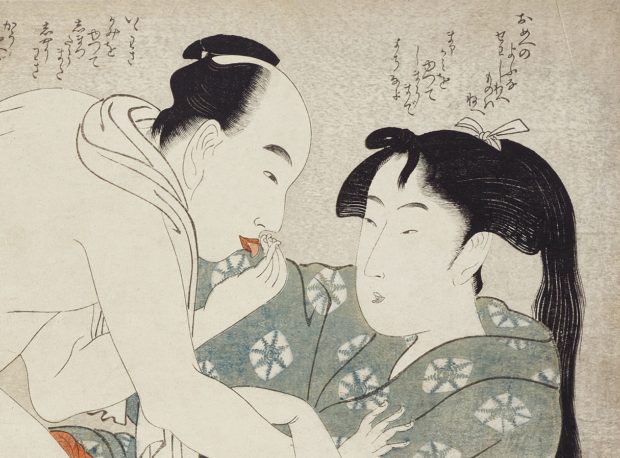Sexually Explicit Japanese Art
Produced from 1600 to 1900 and banned in Japan for much of the 20th century, these explicit and beautifully detailed erotic paintings, prints and books inspired Toulouse-Lautrec, Beardsley, Rodin and Picasso.
Mostly created by the artists of the ukiyo-e or ‘floating world’ school, these popular works were known as shunga, - literally ‘spring pictures’. They appealed to all classes in Japan for almost 300 years, and to men and women alike. Frequently tender and humorous, they celebrate sexual pleasure in all its forms in brilliantly coloured paintings and prints, culminating with beautiful and explicit works by iconic artists Utamaro, Hokusai and Kunisada.
Within Japan, shunga has continued to influence modern forms of art, including manga, anime and Japanese tattoo art. The exhibition sheds new light on this unique art form within Japanese social and cultural history.
 |
Nishikawa Sukenobu (1671-1750), Sexual dalliance between man and geisha, c. 1711-16, hand-coloured woodblock print,. 1985,1022,0.1 © The Trustees of the British Museum.
Hosoda Eishi (1756–1829) Contest of Passion in the Four Seasons (Shiki kyo-en zu), late 1790s–early 1800s; one of a set of four hanging scrolls; ink, colour and gold on silk, Michael Fornitz collection.
Chobunsai Eishi (1756–1829); Young woman dreaming of Ise Monogatari; c. early nineteenth century. Hanging scroll; ink, colour and gold on silk © The Trustees of the British Museum.
Kitagawa Utamaro; Lovers in the upstairs room of a teahouse, from Utamakura (Poem of the Pillow); c. 1788. Sheet from a colour-woodblock printed album © The Trustees of the British Museum.
Attributed to Sumiyoshi Gukei (artist, 1631–1705) and Takenouchi Koretsune (calligrapher, 1640–1704) Series title: Tale of the Brushwood Fence, 17th century; handscroll, ink, colours, gold on paper, Michael Fornitz collection.
Kitagawa Utamaro, ‘Fancy-free type’ (Uwaki no so), from the series Ten Types in the Physiognomic Study of Women (Fujin sogaku juttai), c. 1792-3, colour woodblock print with white mica ground © The Trustees of the British Museum.
Kitagawa Utamaro; Mare ni au koi 稀ニ逢恋 (Love that Rarely Meets); Colour woodblock print; c. 1793-1794 © The Trustees of the British Museum.
Katsushika Hokusai (1760-1849), Diving woman and octopi, page from Kinoe no komatsu (Pine Seedlings on the First Rat Day, or Old True Sophisticates of the Club of Delightful Skills) ,1814, illustrated book, colour woodblock © Michael Fornitz collection, Denmark.
Torii Kiyonaga; Series title: Sode no maki (Handscroll for the Sleeve) Woodblock print; Lovers with roll of tissue; c. 1785 © The Trustees of the British Museum.


.jpg)

.jpg)
.jpg)
.jpg)
.jpg)
.jpg)






.jpg)